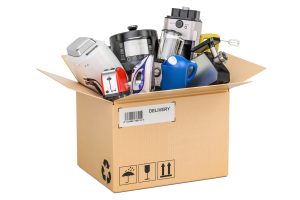Month: June 2019

You’ve sold your house. Congratulations. Now it’s time to start packing – and there is one room that holds plenty of potential issues. So, follow our tips for getting your kitchen ready to go.
Appliances, knives, glasses, tea sets and dishes – whether it’s granny’s pie dish or a multi accessory blender, you’ll want to take care putting each item into a box to avoid breakages or damage. It’s incredible how much clutter builds up in the kitchen, and how little of it we actually use on a daily basis. So, you’ll need to get plenty of packing materials ready, including bubble wrap, tape and strong boxes.
Packing Appliances
Kitchen cupboards are hiding places for gadgets and small appliances, and all their associated parts. Tipping them all into a large box will just end up with a tangle of leads and unidentifiable pieces.
The best thing to pack them in would be the original boxes, if you have them. If not, a sturdy cardboard box will do. Start by cleaning each appliance thoroughly, especially if you are putting them into storage for a time. You don’t want to open the boxes to find mould.
Tie up power cables with elastic bands or, if possible, tape them to the machine. Wrap glass bowls, and sharp blades, and place all attachments in a plastic bag, alongside the appliance. It takes the guesswork out later.
Plan ahead. There are some gadgets you’ll want straight away – kettle, toaster, coffee machine – so put these all in the same box if you can. Remember to write the contents on the outside of the box, so you can find it easily.

Packing knives and the cutlery drawer
Spoons, ladles, spatulas, graters, mashers, ricers, bottle openers and tongs – we have plenty of utensils. We all know what happens when they tangle together in a drawer, which then refuses to open. It may seem a simple idea to tip the entire pile into a box when packing – but imagine the tangle that will greet you when you try to unpack in your new home.
Take the time to have a bit of a sort out as you pack. Group the utensils together in small amounts, wrap each one in a piece of newspaper and tie an elastic band around the handles to keep them together, and the paper on. This will help stop them tangling, and make unpacking easier.
Knives, of course, need a little more care. You certainly don’t want to tip these into a box. By the time you’ve driven to your new home, carried in all the furniture and started to unpack, you’ll have forgotten about loose knives and put your fingers in danger rooting about in the box.
Put all the knives in a separate group or two, and wrap them in bubble wrap. This will ensure that, even if they move about during the drive, they won’t cut through the wrapping. Label the box clearly so you know which one they are in, and are more wary of sharp edges as you unpack.
Packing glasses and fragile items
Start by picking the sturdiest cardboard box you can find. Sort your glasses so that the drinking glasses go in first. Check each one for cracks and chips – perhaps it’s time to get rid of these, saving yourself some space. Wrap each glass individually, tucking the corners of the paper into the mouth of the glass, and place each one mouth down in the box.
Once you have filled the bottom of the box, place a layer of bubble wrap or paper across the glasses before starting the next row. Then, place the more fragile wineglasses and precious crystal on the top row.
Wine glasses can cause their own issues due to the fragile stem. Protect the stem first by winding bubble wrap around it, until the stem is as wide as the rest of the glass, before wrapping in paper and placing in the box.
Finally, remember to label the box clearly and note which way up it should be carried.
Dinner service and tea sets
We don’t all have delicate china tea sets anymore, but if you have, you risk ornamental handles knocked off, and cracks in the plates. Taking care when you pack will help heirlooms and much loved china travel in one piece.
Teacups, like wine glasses, require a little extra bubble wrap to keep the handles intact. For the most delicate of china, the best thing to use as cushioning is packing peanuts. Pack each item individually, and make sure none are touching each other or the bottom if you can.
Stacking plates in boxes may seem simple, but the weight of the stack will easily cause the bottom plates to crack under pressure. Instead, place a layer of paper between each plate, wrapping a corner over the one above, and then stand the plates in the box on their side. Pack scrunched up paper into any gaps or corners, and your plates will be immobile without being crushed.
It might take time, and a lot of extra paper, to pack up your kitchen carefully, but you’ll appreciate it when you can unpack without damage or breakages.
If you need packing materials, we have strong boxes, tape and all the bubblewrap you need in our box shop.
